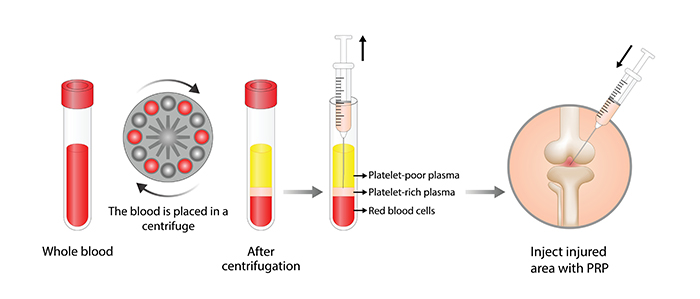Platelet Rich Plasma (PRP) for Elbow Injuries
PRP is a revolutionary treatment that harnesses the power of the patient’s own blood platelets to promote healing and tissue regeneration. Elbow injuries are a common source of pain and dysfunction. Tennis elbow or lateral epicondylitis is the most commonly diagnosed elbow condition caused by micro-tears in the tendon and degeneration caused by repetitive overload.
PRP injections are frequently used to reduce pain and improve function in patients with elbow injuries.

PRP (Platelet-Rich Plasma) is a regenerative medicine therapy that involves the use of a patient’s own blood plasma to promote healing and regeneration of tissues. Blood is composed of several components, including red blood cells, white blood cells, plasma, and platelets.
Platelets are small cells in the blood that play a crucial role in the body’s natural healing process by helping to form blood clots to stop bleeding and by releasing growth factors that stimulate the cells that promote tissue repair.
The growth factors and other proteins present in PRP stimulate and accelerate healing by attracting stem cells and other repair cells to the injured site, promoting tissue regeneration, and reducing inflammation. PRP therapy has been used to treat a variety of conditions, including arthritis, tendonitis, ligament sprains, muscle strains, and more.
A small amount of a patient’s blood is drawn and spun in a centrifuge to separate and concentrate the blood platelets. The concentrated platelets and growth factors are combined with the remaining blood and a local anesthetic for your comfort. This concentrated PRP solution is then injected, under ultrasound guidance, into the affected area of the patient’s body, such as a joint or muscle, to promote healing and tissue regeneration.
Side effects are minimal and may include pain at the site of injection that can last for a few hours or days and swelling that resolves within a few days. After treatment a patient will be advised to rest and avoid exercise for a time.
Generally, it can take up to a month to experience pain relief which will improve over the course of 3-6 months after treatment. However, the recovery period is determined by the type and severity of injury.
PRP has been used in the treatment of various elbow injuries. Use is aimed at enhancing tissue healing, reducing pain, and improving functional outcomes. Below are key applications of PRP for elbow injuries:
Lateral Epicondylitis (Tennis Elbow):
PRP is frequently used for tennis elbow, a common overuse injury of the tendons in the elbow. There is abundant data on PRP for tennis elbow. Studies have shown that PRP can be effective in reducing pain and improving function in these cases. A recent study reported that 70% of patients treated with platelet-rich plasma avoided surgical intervention.
Medial Epicondylitis (Golfer’s Elbow):
Similar to tennis elbow, golfer’s elbow can also benefit from PRP, aiding in the healing of the tendons.
Elbow Tendinopathy:
For chronic tendon issues not responding to conventional treatment, PRP can be an option to avoid surgery.
Ulnar Collateral Ligament injuries:
They are caused by repetitive stress from overhead throwing motions causing pain on the inside of the elbow, instability and decreased performance. There is emerging evidence that PRP can be effective intreating these injuries, particularly in the early stages and for partial tears. PRP may also be an alternative to or a complement to surgery.
The treatment outcomes can be influenced by factors such as the severity of the injury, patient’s age, overall health, and the specific PRP preparation used. Dr. Ajay Lall may consider the use of PRP as part of a comprehensive treatment plan for elbow injuries.
PRP therapy stimulates and accelerates tissue repair and healing without invasive procedures and the associated risks. PRP therapy may significantly improve your function and quality of life.
There are no safety concerns with PRP therapy, and most people experience a permanent reduction or elimination of pain and inflammation.
When you or a loved one suffers with an elbow injury, contact Dr. Ajay Lall to schedule a consultation to receive the correct diagnosis and all your treatment options. We have office in Belvidere, Illinois, Paramus, New Jersey and Philadelphia, PA.
References
- Pretorius J, Habash M, Ghobrial B, Alnajjar R, Ellanti P. Current Status and Advancements in Platelet-Rich Plasma Therapy. Cureus. 2023 Oct 17;15(10):e47176. doi: 10.7759/cureus.47176. PMID: 38021947; PMCID: PMC10652151.
- Kwapisz A, Prabhakar S, Compagnoni R, Sibilska A, Randelli P. Platelet-Rich Plasma for Elbow Pathologies: a Descriptive Review of Current Literature. Curr Rev Musculoskelet Med. 2018 Dec;11(4):598-606. doi: 10.1007/s12178-018-9520-1. PMID: 30255288; PMCID: PMC6220004.
- Watts AC, Morgan BW, Birch A, Nuttall D, Trail IA. Comparing leukocyte-rich platelet-rich plasma injection with surgical intervention for the management of refractory tennis elbow. A prospective randomised trial. Shoulder Elbow. 2020 Feb;12(1):46-53. doi: 10.1177/1758573218809467. Epub 2018 Nov 12. PMID: 32010233; PMCID: PMC6974885.
At a Glance
Ajay C. Lall, MD, MS, FAAOS
- Board Certified – Orthopedic Surgery
- Triple Fellowship Trained
- Performs over 750 Surgeries Per Year
- Learn more

